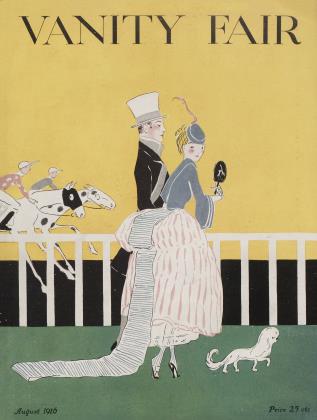Sign In to Your Account
Subscribers have complete access to the archive.
Sign In Not a Subscriber?Join NowDAIRY COWS ARE PERFORMING MIRACLES
These Three Alone Produced Over Thirty-five Tons of Milk in a Single Year
REGINALD MCINTOSH CLEVELAND
PERHAPS the most wonderful machine in all this age of mechanical wonders is not an inanimate piece of mechanism at all, but a living and breathing animal; in short, a cow. The modern dairy cow, born to the purple, is almost as different in the matter of milk and butter production from the common or "family" variety as it is possible for one animal to differ from another of the same species. In fact there is much more of a gap, from this point of view, between cows of the type illustrated on this page and the farmyard "bossy" than there is between the thoroughbred race horse and the cabby's nag. It is hard, to believe that an animal can produce in a year nearly or quite its own weight. in butter and perhaps twenty-five times its own weight in milk.
This is a subject on which one cannot talk intelligently without recourse to figures and, in this case, the figures are so startling that they lose most of their customary dryness. Therefore let us plunge bravely into some. If you were to divide all the cows in the United States into three groups and label the first good, the second fair and the third poor, the average annual production of milk by each cow in these divisions would be 6,765, 5,000 and 3,654 pounds respectively, and the average annual butter-fat production would be 278, 198 and 154 pounds respectively. But the average production of 4,811 animals entered in the advanced registry of the American Guernsey Cattle Club is 8,815 pounds of milk and 439 pounds of butter-fat for each cow each year. A similar average of the Jerseys and Holsteins of pure bred stock and entered for the register of merit would show a comparable contrast with the average for just cows. Moreover, in using the figures for the best producing third of all the cows in the country it must be remembered that these aristocrats are themselves included in that third and help to make its showing better.
WHEN the comparison is brought down to individual animals the contrast becomes, of course, far more striking. It is an exceptionally good plain cow, of the sort our grandfathers used to raise, that will give 9,000 pounds of milk and 350 pounds of butter in a year, but the leading Jersey, Sophie 19th of Hood Farm, produced 17,557 pounds of milk and 999 pounds of butter-fat, equivalent of 1,175 pounds of butter, in a year. Murne Cowan, the leader of the Guernseys, produced 24.008 pounds of milk and 1,098 pounds of butter-fat and the leading Holstein produced nearly 30,000 pounds of milk, and a fraction more than 1,100 pounds of butter-fat in the year!
This marvelous development of the cow's special aptitudes has been accomplished by rigid selection and breeding in each of these three dairy breeds and by the establishment of a system of carefully supervised and checked records of production and feeding, extending over 365 days and variously called the Advanced Registry or the Register of Merit. This register has nothing to do with the registry of the animal & to pure blood except that that is a prerequisite for the advanced work. Cows cannot have their records entered on the Advanced Registry unless their production equals a certain minimum requirement which is increased as the animals grow older up to five years.
THE greatest possible care is taken of the cows on test and most of these highly bred animals are milked three times and, in some cases, four times a day. Their feeding is a fine art and expert study is given to the subject of "balancing" their rations as it is called. At one of the greatest dairy farms in the world, that of Ohio C. Barber at Barberton, Ohio, where at one time more than two hundred Guernseys were on test, the feeding expert personally weighed! and measured eachration, chosing as the time of day in which he was least likely to be disturbed the hours from midnight to two o'clock in the morning.
A S to the relative -merits of the three breeds under discussion here, it may be said that each has its place. The so-called "Channel Island" breeds, the Guernseys and the Jerseys,; give less milk than the Hoisteins', but on the average milk which is far more rich in butter-fat. and more highly colored. For the farm where quantity of milk is the object Holsteins are the ideal cows: For that, on the other hand, where the desire is for cream and butter especially, the orange-and-white Guernsey or the fawn-colored Jersey, is to be.preferred to the. black-andwhite breed. All three are wonderful examples of what the patience of man can accomplish. The thanks of all who have an interest in dairying, and this includes nearly the entire population, are due to the American Jersey Cattle Club, the American Guernsey Cattle Club and the Holstein-Friesian Association, for the work they have done for their special varieties and the cause of good milk and good butter in general.
 View Full Issue
View Full Issue












Subscribers have complete access to the archive.
Sign In Not a Subscriber?Join Now